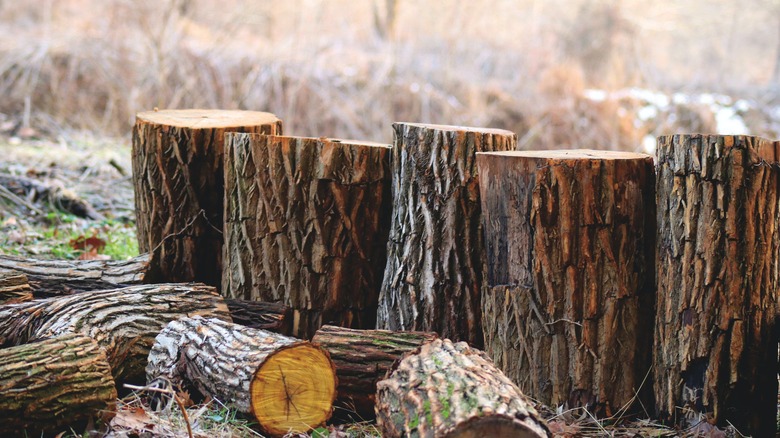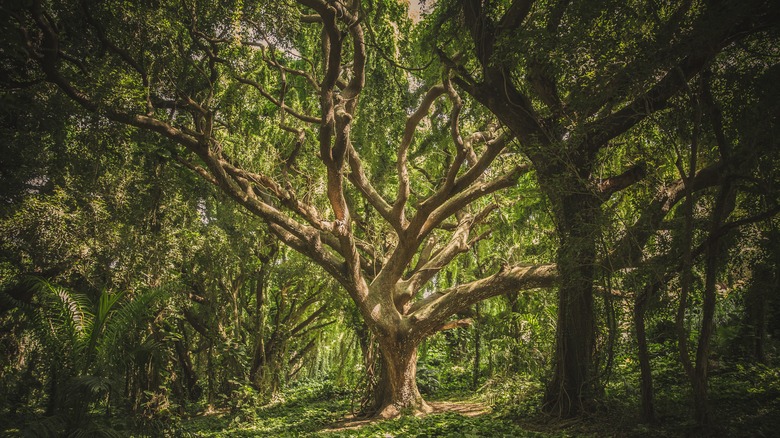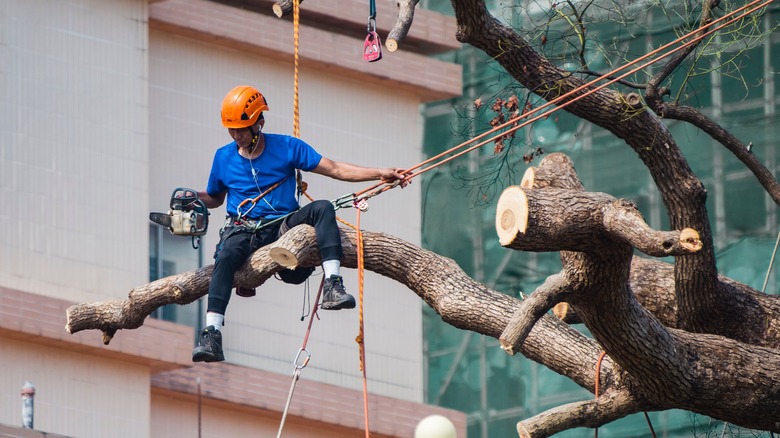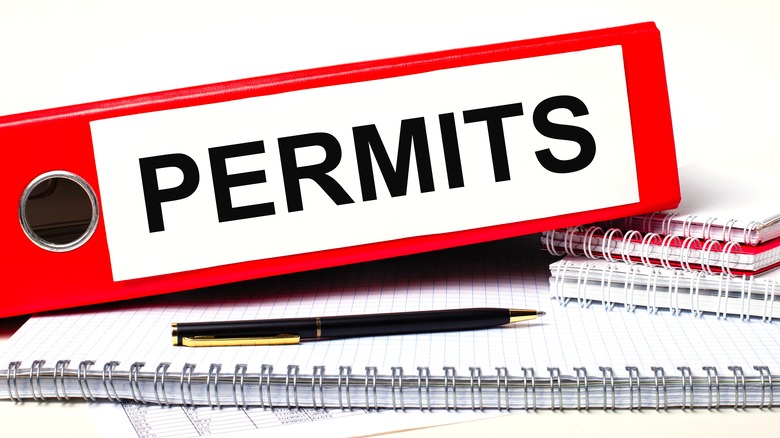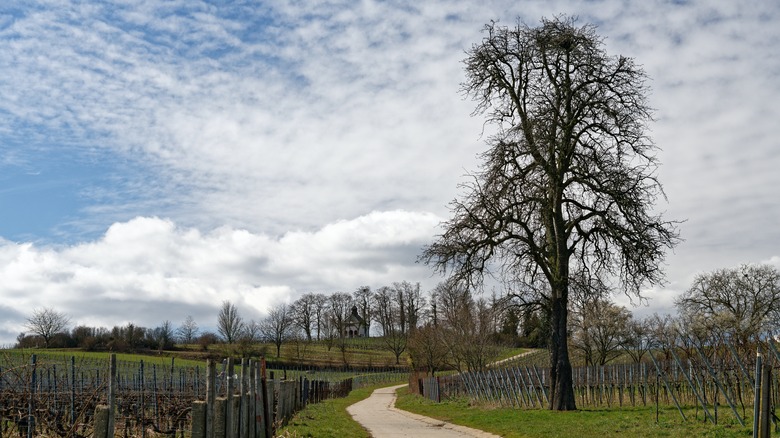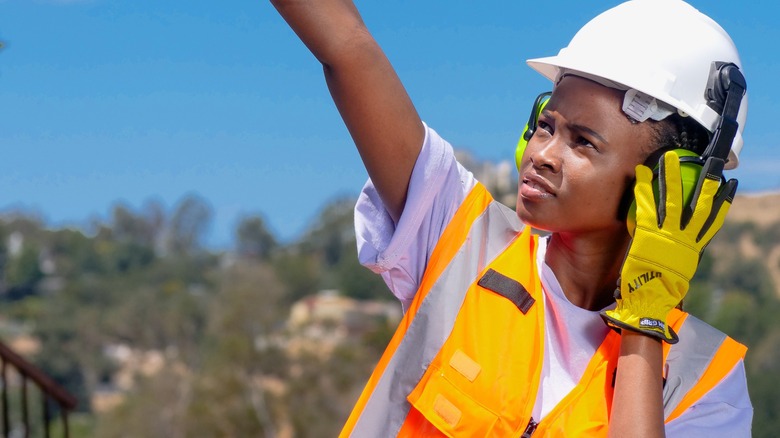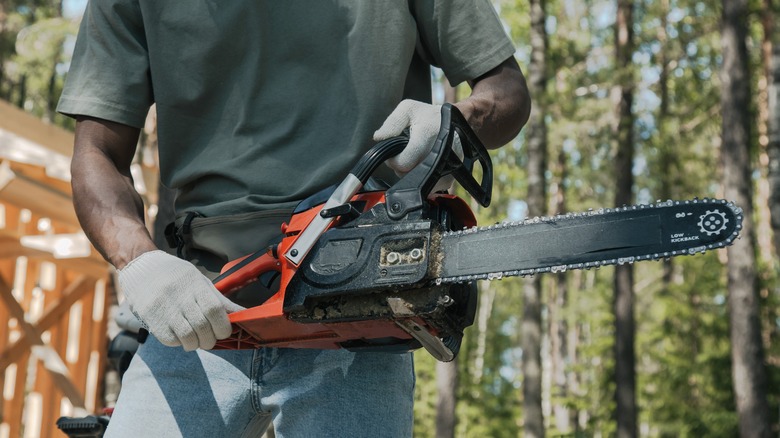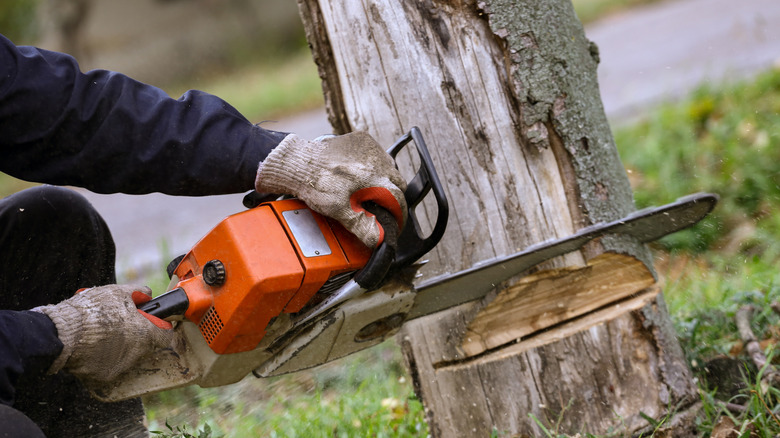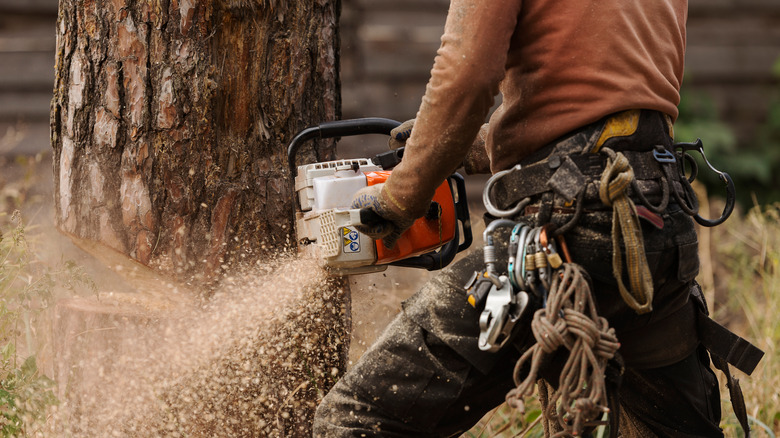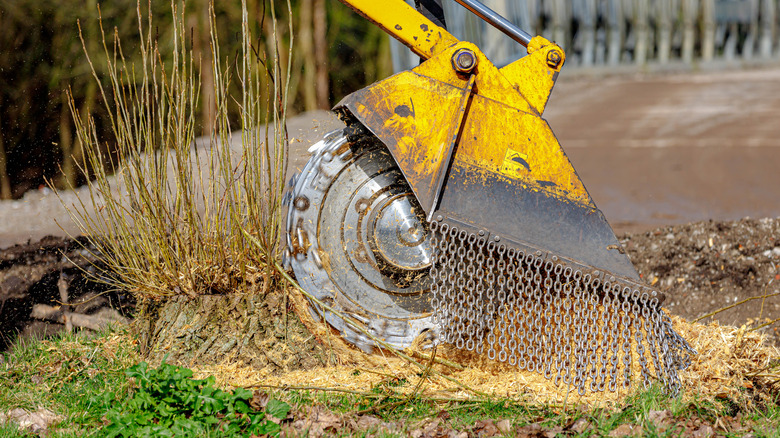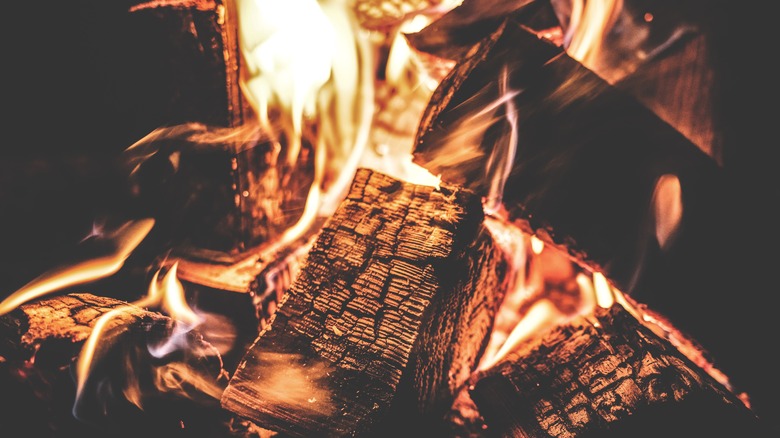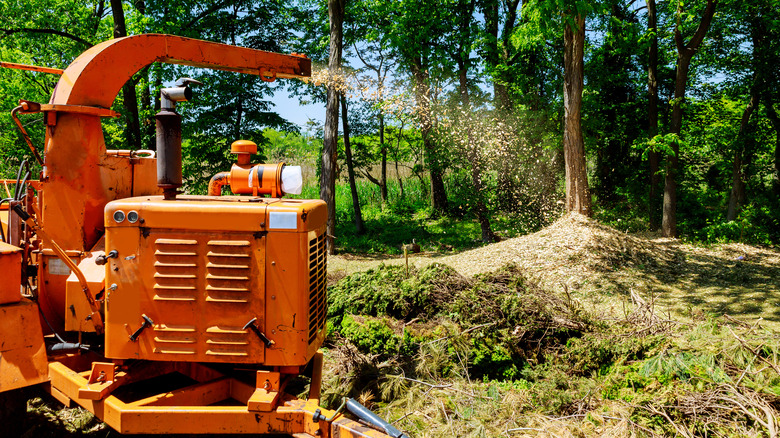Everything You Need To Know To Cut Down Trees In Your Yard
Why cut down trees in your yard in the first place? There are quite a few reasons to tackle the project. Perhaps your dream sunroom has all of the perfect windows, the best seating for sipping coffee, and you long to soak up the sun, but is your view blocked by towering trees that started out small? Often homeowners opt for a yard with fewer trees and more sun. Or perhaps you want to replace your current trees with something with flowers or even fruit.
Other reasons aren't just about appearances. Several landowners are forced to remove trees if they begin to grow too close to a house, garage, or driveway. If a tree has outgrown the space, then it can pose a risk. If there's a storm and the tree falls towards the house or your cars, you could be in for a very expensive bill. Dying or sick trees, if they are damaged or become infected with a disease, may need to be removed. They could fall, becoming dangerous hazards, the disease may spread, the tree could attract harmful bugs, or they may just appear unsightly. Finally, one of the most common reasons that trees must be removed is if the roots begin to interfere with the foundation of the home or even the septic system, according to Purdue University. Trees can also grow to interfere with power lines and satellites as well.
There are many reasons to cut the trees down in your yard, but what does cutting one down actually entail? Should you hire a professional; what are the risks; how difficult is the process? These are all questions to consider before attempting the task. Follow these steps and helpful hints before firing up your chainsaw.
Is that tree protected by the government?
Everyone knows that you should contact your gas company and tread carefully when digging, so as not to hit a gas line or other important pipes that can be in your yard. However, not everyone thinks to check in with regulations about certain trees before they go chopping them down and mulching them up.
Each individual state has certain restrictions when it comes to protected trees. Why are certain trees protected? According to Tree Removal, these regulations are usually in place, not to make your life harder, but to either preserve certain species or to adhere to certain city regulations. For example, in California, heritage trees, or certain oak trees, are protected and require permits to even prune them because they are considered living landmarks (via the City of San Mateo California).
Do a little research before you start chopping. The last thing you need is to break government laws that are put in place to protect the natural environment. This will save you time and hassle. Additionally, there are regulations that are meant to protect utility lines and other power lines, according to Tree Removal. Always be aware of any power lines that are within the area. A tree typically shouldn't be planted within 20 feet of lines. If a tree has grown or was planted before the lines were put in place there's a risk of that tree falling on the power line when it's cut down. Take careful inventory of any utility lines and plan accordingly.
Consult an arborist
What is an arborist? Put in simple terms, an arborist is a tree doctor, or a tree expert. According to American Arborists, these professionals are experts when it comes to shrubs, trees, and more. They understand the science behind caring for trees. If you have questions about how to maintain a tree, tree diseases, or even planting trees, you can consult these specialists.
How can they help? Have you noticed the tree in your yard looking a little worse for wear? If the leaves are dying, the branches are breaking off, or if you've noticed peeling bark or fungus growing, then an arborist can help. If you love the trees in your yard, paid a hefty price for them, or simply do not want to deal with removing them, these experts may be able to help diagnose the problem and offer a solution before you send them to the chopping block.
What services do arborists offer? Arborists can assist with planting a tree. You don't want to blindly spend a fortune and plant a forest on your property only to find out that the species you chose doesn't thrive in your climate, could cause damage to your foundation, or they grow much slower than you expected. All of these issues can be handled by a specialist and perhaps prevent unnecessary tree removal in the future. Tree pruning, tree maintenance, urban forest management, drought planning, and even tree removal are often services offered by arborists.
What permits are required
Do you need a permit to cut down a tree on your own property? This is an excellent and important question that should be addressed early on. The answer is that it depends on each individual state, according to Tree Removal. The laws and regulations are unique to each area. In Utah, for example, heritage trees are also protected and require a permit or may not be able to be cut down at all. The protected species are often uncommon or threatened and could greatly impact the environment if they disappear.
Research your specific area at the beginning of your project. Speaking to neighbors is not enough. Check out reliable sources online or within your county before giving yourself the green light. For example, in Detroit, Michigan, in 2002, an invasive species of exotic beetles, called the Emerald Ash Borer, was causing excessive damage to ash trees (via Emerald Ash Borer Information Network). In order to battle the infestation, the government put strict laws into place about how to report Emerald Ash Borers and how to dispose of these infected trees. If you are new to an area or if you've never removed trees in your area before, do your research!
Understand your limits and the area/tree
Removing trees will likely involve a chainsaw, which is a powerful and extremely dangerous machine, and other heavy equipment. Not to mention a large heavy tree is going to fall down. This means that you and anyone assisting you need to be careful and comfortable with the task at hand before getting started. Tree removal is dangerous and should be taken seriously. According to The National Library of Medicine, research in just the state of Connecticut revealed that between 2014 and 2019, 64 deaths were the result of tree mishaps. Injuries and fatalities can occur and you do not want to become part of a statistic.
If you haven't removed a tree before, perhaps a three-foot wide oak tree that towers above you is not a good starting point. Take time to assess the situation. Ask yourself how much room you have and plan for emergencies. Trees tend to fall as they lean, but that's not guaranteed. Consider what could happen if the tree does not fall the way you anticipate. If the tree is in a tight space or if the tree is too large, you should consider hiring or consulting a professional tree removal company, even if you have experience.
Don't skimp on safety gear
Safety is of the utmost importance when it comes to cutting down trees. Small or large, tall or wide, the unexpected can always happen. Even if the tree is tiny and you aren't anticipating trouble, you are still handling dangerous equipment and there's no way to predict every outcome. According to the National Ag Safety Database, the most common type of injury related to tree removal is electrocution, falling or slipping from the tree or ladder, and being hit with a branch or tree. Trees can fall in unexpected ways, they can splinter and break, pieces can fly off, and machinery can malfunction. Safety gear is crucial. Make sure you are well prepared with these items.
The basic safety gear needed for tree removal includes a hard hat to protect your head from falling branches or chunks of wood, safety goggles will protect your eyes from splinters of wood and debris, non-slip boots, gloves, long pants or cut-resistant leg protectors, and headphones or earplugs in your working with loud machinery. These can all protect your body but also keep you from slipping and falling, which can be just as harmful.
Understanding your equipment
Chainsaws are not about brute force, they are sophisticated machines that can make your job, whether it's professional or personal, much easier.
First, understand your needs and the different tools available. According to STIHL, there are different chainsaws for cutting firewood, felling trees, and even more precise jobs such as pruning and trimming. The price, mobility, how to start the machine, and weight are other factors that will determine which saw is right for you. Homeowners who have occasional small jobs, might consider a saw that is a combination of power and value. These are typically smaller, and they offer protection features, such as anti-vibration and quickstop, which will help less-experienced owners.
If you're felling trees and working on bigger jobs, then you might consider a professional chainsaw or at least a farm and ranch saw, which are specifically designed for more difficult jobs that take more time. Farm and ranch saws are usually designed for long jobs, such as storm clean up when the machine is going to run for an extended time. Professional saws are designed for the big jobs and bigger trees. They can typically withstand a lot of wear and tear. A professional saw is different because it has a powerful, durable engine. The design is also usually geared towards comfort and has a vibration system that limits too much motion. They are also made to make maintenance easier with a larger surface air filter and air injection cleaning systems. Do not assume your everyday chainsaw can handle a large tree removal job (via Chainsaws Direct). The last thing you want is for a tree to be half cut and unstable while you make repairs or hunt down another machine.
Cutting the notch
Once you've prepared for the job, established an escape route, cleared the area, and are ready to start cutting, you will begin with an important step, cutting the notch. According to Chainsaw Academy, you will make this cut on the side of the tree that points in the direction that you want the tree to fall toward. If the tree has a natural lean to the right and you want it to fall to the right then your first cut will be on the right. This directional cut will help safely steer the fall.
There are different types of notches to choose from, which mainly depend on the terrain that the trees are growing in, and the type of tree. An open-faced notch with the top aiming cut is the most commonly used and involves a flat cut at low-stump height and a slightly slanted cut from the top that meets the flat cut. This creates an angled notch that will work as a hinge when the tree falls. A similar notch that has a bottom aiming cut is better for trees that commonly split or break while cutting. The open-faced notch with a larger opening angle of approximately 70-degrees or more gives the cutter more control and has a higher stump. The Humboldt cut or inverse notch is an upside down version of the open-faced notch, with the flat cut on top and the angled cut on the bottom. This cut is used to guide trees that are on a slope or hill.
There are other options when it comes to cutting notches, but more complicated versions should be handled by professionals. These are the four most common cuts that experienced cutters use.
Making the fell cut
There are a few different methods when you're making the fell cut and they depend on the type, size, and slope of the tree. The fell cut is the last cut that you'll make and there are a few important things to remember. According to the Husqvarna Chainsaw Academy, the most important step to remember is to make the fell cut line up with the flat line of the notch, whether it's at the bottom or the top of the notch. This will ensure a smoother fall and prevent too much breaking, snapping and splitting.
Here are the most common, safe methods for fell cuts. The straight from behind cut is one straight cut about ⅔ of the way through the tree, almost meeting the directional notch, but not touching. Pull the chainsaw straight away towards your body to safely remove the blade and chain from the wood. This method works for smaller and thicker trees that aren't leaning and aren't being cut in high winds.
The behind felling cut that uses a bumper spike is a method that should also line up with the notch, except you start closer to the notch cut, and pivot the saw to meet the other side. You're still only cutting about ⅔ of the way through the circumference and not meeting the notch. Once you saw about half way, wedge the bumper strike in carefully and then continue the cut until your blade is parallel with the notch cut and then pull the saw straight out. There are other methods but these are great options for small jobs.
Stump grinders and removal
You've successfully and safely removed the trees in your yard but that's not the last step. There's a bit more work to do with the leftover stumps. Whether you are replanting, building, or laying down sod, a stump is not very pleasing to the eye and will likely be in the way of your next project. According to American Climbers, trees cannot be cut down without leaving behind at least a very low stump. However, it's up to the owner to decide if stump removal is necessary. Once a tree is removed, a stump may really stand out in an otherwise manicured lawn.
There are a few DIY tricks when it comes to stump removal; however, many of these are not safe, they can be expensive, and they can take a very long time to work. Stump grinders and stump removers are large pieces of equipment that either grind the stump down to prevent regrowth or they bore into the stump tearing up the roots and stump. Large chunks of wood often fly and break apart, which makes stump removal another serious part of tree removal and you should consider hiring a professional for this step. Renting equipment, supplying gas, clean up and liability insurance are only a few expenses to consider if you're planning to do this portion by yourself. A professional may be comparable in price, leaving you without the hassle.
Burning trees after removal
If you've felled the tree and removed the stump, the next step is cleanup. How do you safely and legally get rid of the leftover wood from tree removal? You may be tempted to start a bonfire right then and there, but there's more you need to know about burning.
FIrst, there's always a risk when it comes to burning. Research and experience are important as fire can be unpredictable and extremely harmful to people and the environment. Depending on the size of the tree, you could have enough wood for a bonfire, or you may be looking at a mountain-sized pile of wood. According to the Connecticut Department of Energy and Environmental Protection, burning outside where the smoke is open to the air and doesn't pass through a stack of any kind would be considered open burning. There are a lot of restrictions, schedules, and warnings for open burning depending on each individual area and it's downright illegal in some places.
Burning wood is not as toxic as burning other materials, such as plastic or garbage; however, any smoke can cause problems for people with respiratory issues and introduce toxins into the air. The risk of forest fires and property damage are other reasons why open burning is often illegal. In the areas where open burning is legal, there are still certain times of the year and day when you cannot and certain warnings may be issued if there are dry spells or high risks. Be sure to check conditions on the day you plan to burn.
Everything to know about tree mulchers
You can hire a professional to remove trees from your yard. A professional will have the correct permits and equipment and will know where to dispose of the trees; however, another option after you remove a tree is to mulch it. According to GPH Grading, forestry mulching is an option when you are clearing your land of trees, shrubs, brush, branches, and grass that only requires one machine. All of the vegetation is passed through the different mulchers and shredded on the spot, rather than hauling trees and brush away. This method of removal and clean-up is environmentally better than burning and it can leave you with a layer of organic matter that can help fertilize your soil and serve as a protective insulation layer, or simply a decomposable layer that can be great for filling in parts of your lawn and much more.
There are several different types of mulchers, all ranging in size and power. The equipment really depends on the size of the job and what exactly needs to be mulched. There are mulchers that can be rented; however, they pose safety risks. Hiring a professional to handle mulching is the safest option.
